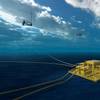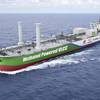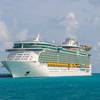As Freight Rates Fall, LNG Shippers Brace Consolidation
Faltering LNG demand, growing tanker fleet drag on freight rates.
Shippers who ply the seas to deliver liquefied natural gas (LNG) in massive tankers are likely to face a wave of consolidation and asset sales, with freight rates plunging as a growing fleet clashes with tepid demand.
Companies that manage to weather the shakeout in one of the key sectors in the global shipping industry should be in a prime position, however, to benefit from a string of new LNG projects expected to start trickling online by the end of next year.
"I see more mergers and acquisitions, more consolidation and a lot more joint ventures as things get tougher," said Andrew Bridson, business development manager at maritime consultancy BMT Asia Pacific.
"That is not a bad thing. Consolidation will force out failing companies and cull a lot of the older tonnage."
LNG transportation was once considered a bright spot in a global shipping industry that has been in its worst downturn in 30 years. But freight rates have halved since 2014 as appetite for LNG wavers in the face of stuttering economies in key markets such as China and South Korea, while the global tanker fleet is expected to grow nearly 10 percent a year from 2015 to 2017 as ships ordered earlier are completed.
Spot charter rates for a 160,000 cubic metre LNG carrier are currently around $32,000 per day, down from $72,000 in 2014 and over $100,000 in 2013, according to data from British shipping services firm Clarkson.
LNG tankers need to earn $60,000-$80,000 a day to cover capital and operating costs, shipping experts said.
To make it through the downturn, analysts and industry officials predict that some shippers will merge, while others will look to offload assets or club together in operating ventures.
A handful of smaller operators including Excelerate Energy, owned by U.S. oil magnate George Kaiser, and Norway's Awilco have already received takeover offers or are selling older vessels.
Flex LNG, with just two LNG carriers, said it was looking for other consolidation opportunities after its $2.3 million merger with shipper Exmar was scuppered in September.
Meanwhile, Golar LNG, Dynagas and GasLog Ltd launched the Cool Pool vessel marketing venture with 14 gas carriers in October to reduce operating costs and support spot charter rates.
"I expect to see another LNG ship owners pool emerge," said an LNG ship broker, declining to be identified as he was not authorised to speak with media.
Elsewhere, the $70 billion acquisition of BG Group by Royal Dutch Shell PLC will create a 70-strong LNG shipping fleet, one of the biggest in the world, rivaling Japan's Nippon Yusen Kaisha and Mitsui O.S.K. Lines .
AFTER THE STORM
Those shippers left as part of a leaner industry will be set to capitalise down the line as new or delayed gas export projects in Australia, North America and Africa start operating.
These include the Queensland Curtis LNG plant in Australia and Cheniere Energy's Sabine Pass export facility in the United States, which will receive its first tanker for loading on Jan. 12.
"That is going to bring out more LNG onto the market and that is going to need more ships," said Peter Evensen, chief executive at shipper Teekay GP.
Indeed, the longer term picture looks brighter, with analysts forecasting demand for LNG will grow to 410 million tonnes by 2025 from 249 million tonnes this year as the global economy starts to pick up.
The outlook for the fuel was also boosted by a historic climate change agreement signed by world leaders in Paris this month, helping pave the way for a major shift away from coal towards cleaner fuels such as gas.
Reporting by Keith Wallis












